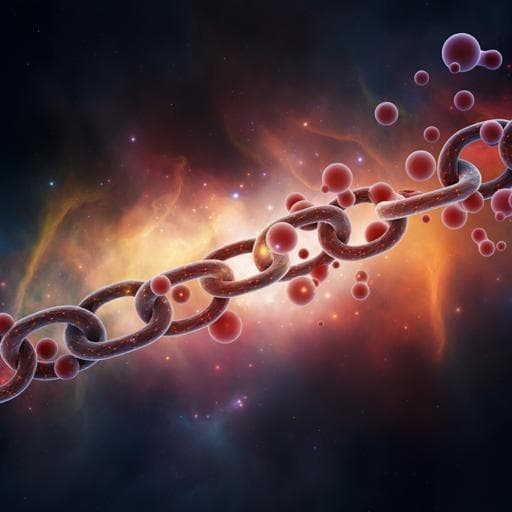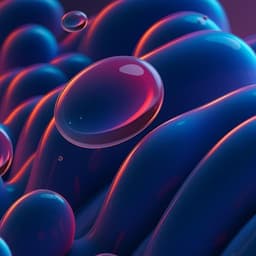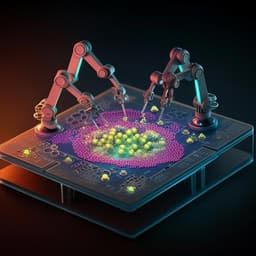
Chemistry
Self-assembly using a retro Diels-Alder reaction
J. Park, J. Heo, et al.
Discover a groundbreaking self-assembly method triggered by a retro Diels-Alder reaction, developed by Jaeyoung Park and colleagues from Hanyang University. This innovative approach not only generates building blocks for supramolecular polymers but also produces functional groups for creating advanced colorimetric sensors that respond to various stimuli.
~3 min • Beginner • English
Introduction
The study addresses how retro Diels-Alder (rDA) reactions can be harnessed to trigger self-assembly and subsequent polymerization on solid substrates. Conventional precursor-based self-assembly methods rely on stimuli such as heat, light, pH, or enzymes to convert precursors into self-assembling units, but most operate in solution and often disrupt rather than create assemblies on solid surfaces. The authors propose using an rDA reaction on a sterically hindered furan–maleimide Diels-Alder adduct (1-endo) to release two linear, diacetylene-bearing lipid building blocks that spontaneously self-assemble and can be photopolymerized into polydiacetylene (PDA). This approach aims to enable solid-state, spatially controlled triggering of assembly, while generating reactive headgroups (maleimide and furan) for post-assembly functionalization and enabling unique thermochromic properties.
Literature Review
Self-assembly is a bottom-up strategy widely used to construct biomimetic functional materials and supramolecular polymers. Precursor strategies control assembly via external stimuli: thermal triggers exploit thermo-responsive segments; light triggers include azobenzene cis–trans isomerization and o-nitrobenzyl photocleavage; pH changes convert soluble ionized forms to hydrogen-bonding neutral species; and enzymes cleave polar segments to induce aggregation. However, most triggering methods function in solution; few effectively create assemblies on solid surfaces. While azobenzene photoisomerization can occur in solids, it is often used to disrupt assemblies via trans-to-cis switching. DA/rDA chemistry is extensively used in materials for self-healing, surface modification, controlled release, and reversible networks, often employing furan–maleimide pairs with tunable endo/exo ratios. Despite this, DA/rDA-triggered self-assembly has been scarcely explored. Prior work on polydiacetylene (PDA) systems shows strong chromic responses and, with special headgroup interactions, potential for reversible thermochromism. The present work leverages rDA to generate self-assembling diacetylenes on substrates, with built-in reactive headgroups for further modulation.
Methodology
Design: A bis-diacetylene-linked furan–maleimide Diels-Alder adduct (1-endo) was synthesized as a sterically hindered, bent precursor expected to resist self-assembly. Upon heating, rDA generates two diacetylene-bearing lipids: a furan derivative (F) and a maleimide derivative (M) that can co-assemble and undergo UV-induced topochemical polymerization to PDA.
Materials and instrumentation: 10,12-Pentacosadiynoic acid (PCDA), furfuryl alcohol, and N-(4-hydroxyphenyl) maleimide were used as starting materials. Spectroscopies: Raman (785 nm), UV–Vis (Agilent 8453), FT-IR (ATR), 1H/13C NMR (600 MHz, CDCl3), HRMS (TOF). Thermal analyses: DSC; structural analysis: powder XRD.
Solid-state rDA and polymerization on glass: Powder 1-endo (3 mg) on glass was heated at 110 °C for 1 min, then stabilized in a freezer (-10 °C, 10 min) and UV-irradiated (254 nm, 1 mW cm−2, 1 min) to induce PDA formation. Product distributions were quantified by dissolving treated samples in CDCl3 and analyzing 1H NMR; temperature- and time-dependent rDA profiles were obtained by heating at 90–140 °C for 1 min or at 110 °C for 0–30 min.
On filter paper: A 10 mM ethyl acetate solution of 1-endo was drop-cast (100 μL on 2 cm filter). The paper was heated at 110 °C for 5 min (rDA), stabilized (room temperature 20 min or -10 °C for 10 min), then UV irradiated (254 nm, 1 mW cm−2, 1 min). PDA formation was monitored visually (blue color), by UV–Vis (620 nm), Raman (ene–yne at 1458 and 2074 cm−1), and XRD. Conversion to PDA was estimated by washing heat-only and heat+UV samples, concentrating, and 1H NMR analysis of residual F and M.
Controls and comparisons: 1-exo was prepared and similarly tested. Independently synthesized F and M were used for assignment and control experiments, including direct self-assembly (1:1) and polymerization to assess thermochromism and DA adduct formation. Quenched samples (liquid nitrogen) were analyzed by XRD to probe intermediate assembly states.
Cysteine sensing: PDA-coated papers (from 1-endo via rDA+UV) were exposed to 10 mM amino acids in PBS–EtOH (1:1 v/v, pH 7.4) for 30 min. Selectivity and chromic response were evaluated visually and by UV–Vis (620 and 535 nm). FT-IR of PDA derived from self-assembled M assessed thiol–maleimide adduct formation via shifts in maleimide bands.
Thermochromic reversibility: PDA films were subjected to thermal cycling; effects of annealing rDA products prior to UV polymerization were tested (18 h at 35 °C or 45 °C) to probe DA reformation between furan and maleimide headgroups. Reversibility temperature ranges were recorded. Solution rDA control: 1-endo in CDCl3 was heated (e.g., 110 °C, 30 min), drop-cast, polymerized, and its thermochromism assessed for comparison.
Key Findings
- rDA-triggered self-assembly on solid supports: 1-endo on filter paper or glass showed no color change upon direct UV (254 nm, 1 min), indicating misaligned diacetylenes due to steric hindrance. Heating (110 °C) induced rDA, yielding F and M that self-assembled and polymerized to blue PDA upon UV exposure.
- Spectroscopic signatures: PDA displayed a characteristic absorption maximum at 620 nm; Raman spectra showed ene–yne bands at 1458 and 2074 cm−1 in heat+UV regions, while monomeric diacetylene at 2264 cm−1 remained in unheated regions.
- Structural metrics: Post-rDA XRD exhibited a sharp peak at 2θ = 23.12° (d ≈ 3.8 Å), consistent with optimal PDA topochemical geometry; 1-exo after heat showed 2θ = 20.94° (d ≈ 4.2 Å), unfavorable for polymerization, and indeed 1-exo-coated papers did not polymerize under identical conditions.
- Process optimization: Stabilization after rDA (freezer -10 °C for 10 min or RT 20 min) increased polymerization efficiency (higher 620 nm intensity). UV irradiation saturation occurred at ~1 min. Approximately 40% of rDA products (F and M) were converted to PDA; incomplete conversion was attributed to limited UV penetration into the paper interior.
- rDA kinetics and selectivity: 1H NMR showed rDA onset at ~90 °C, increasing conversion to F and M up to ~130 °C; endo→exo isomerization began at ~120 °C. At 110 °C, 1-endo consumption reached ~50% after 1 min, ~85% after 5 min; F and M maximized at ~5 min before declining with further heating; 1-exo formation appeared after 5 min and peaked by ~10 min. Optimal rDA for assembly was 110 °C, 1 min on glass (5 min on filter paper due to slower heat transfer).
- Homogeneous F/M mixtures: DSC of rDA products showed a single endotherm for the F/M mixture (≈50–54 °C), indicating homogeneous mixing without phase separation.
- Selective thiol sensing: PDA films exhibited a selective blue-to-red transition upon exposure to 10 mM cysteine (no response to other amino acids). UV–Vis showed a decrease at 620 nm and increase at 535 nm. FT-IR on M-derived PDA confirmed thiol–maleimide adduct formation (maleimide C=O shift 1685→1712 cm−1; loss of C–C stretch at 1601 cm−1).
- Thermochromic reversibility tunable by annealing: PDA from solid-state rDA showed reversible thermochromism (blue↔purple) between 25–40 °C without annealing; annealing rDA products for 18 h at 35 °C extended reversibility up to ~60 °C; annealing at 45 °C extended reversibility up to ~80 °C. 1H NMR evidenced DA adduct reformation during annealing: relative 1-endo increased from 0.22 (no anneal) to 0.23 (35 °C) and 0.29 (45 °C); 1-exo increased 0.08→0.09→0.14. Increased DA content acts as a molecular clamp enhancing reversibility.
- Assembly pathway dependence: PDA formed from solution-phase rDA products exhibited irreversible thermochromism at ~40 °C, and PDA from direct self-assembly of F+M (1:1) showed no reversible thermochromism, correlating with minimal DA adduct formation under those conditions.
Discussion
The findings demonstrate that an rDA reaction can effectively trigger self-assembly of otherwise sterically hindered precursors on solid substrates, addressing a key limitation of many precursor-based approaches that operate only in solution. Heating 1-endo releases two linear, diacetylene-bearing lipids (F and M) that co-assemble into an arrangement optimal for topochemical polymerization, as confirmed by XRD and the emergence of blue PDA with characteristic spectral signatures. The ability to localize rDA by spatially controlled heating yields patterned PDA formation after UV exposure, opening routes to device fabrication and lithography-like processes.
A significant advantage of this strategy is the in situ generation of reactive maleimide and furan headgroups within the assembled and polymerized matrices, enabling post-assembly chemical modification and functional responses. This was exemplified by selective cysteine sensing via thiol–maleimide Michael addition, producing a robust colorimetric signal. Furthermore, the dynamic DA/rDA chemistry between furan and maleimide within the assembled state provides a molecular clamping mechanism: annealing allows partial re-formation of DA adducts that, after polymerization, stabilize the PDA conformation and markedly enhance thermochromic reversibility to higher temperatures. The contrast with solution-derived or directly co-assembled systems underscores the importance of the solid-state rDA assembly pathway in dictating molecular packing, DA adduct content, and macroscopic properties.
Overall, rDA-triggered self-assembly offers a versatile platform for creating functional supramolecular polymers on surfaces with tunable sensing and thermochromic behaviors, relevant to sensors, smart coatings, and patterned optoelectronic materials.
Conclusion
This work introduces an rDA-triggered solid-state self-assembly strategy that converts a sterically hindered furan–maleimide DA adduct (1-endo) into two diacetylene lipids that co-assemble and photopolymerize to polydiacetylene. The approach enables substrate-supported, spatially addressable assembly, generates reactive headgroups for post-functionalization, and yields PDAs with tunable, highly reversible thermochromism via in situ DA re-formation during annealing. The method also affords selective biothiol sensing through maleimide chemistry. These advances suggest broad applicability to other self-assembling platforms (e.g., π-conjugated chromophores, peptides) and integration into patterned device architectures. Future research could expand the chemical scope of precursors and headgroups, optimize light penetration and film architectures to increase polymer conversion, and engineer DA kinetics to tailor mechanical and chromic responses.
Limitations
- Incomplete polymer conversion (~40% of rDA products to PDA) due to limited UV penetration, leaving unpolymerized material within the interior of porous substrates (filter paper).
- Temperature sensitivity: Efficient rDA requires elevated temperatures (~110 °C), and prolonged heating promotes undesired endo→exo isomerization that hinders polymerization and reduces blue color intensity.
- Substrate-dependent heat transfer: Longer heating is needed on filter paper than on glass, affecting processing uniformity.
- Pathway dependence: Assemblies formed from solution-phase rDA products or direct F/M mixtures lack reversible thermochromism, indicating sensitivity to assembly history and packing.
- Formation of 1-exo during higher-temperature annealing can diminish polymerization efficiency and color intensity, imposing a trade-off between thermochromic reversibility and chromic contrast.
Related Publications
Explore these studies to deepen your understanding of the subject.







